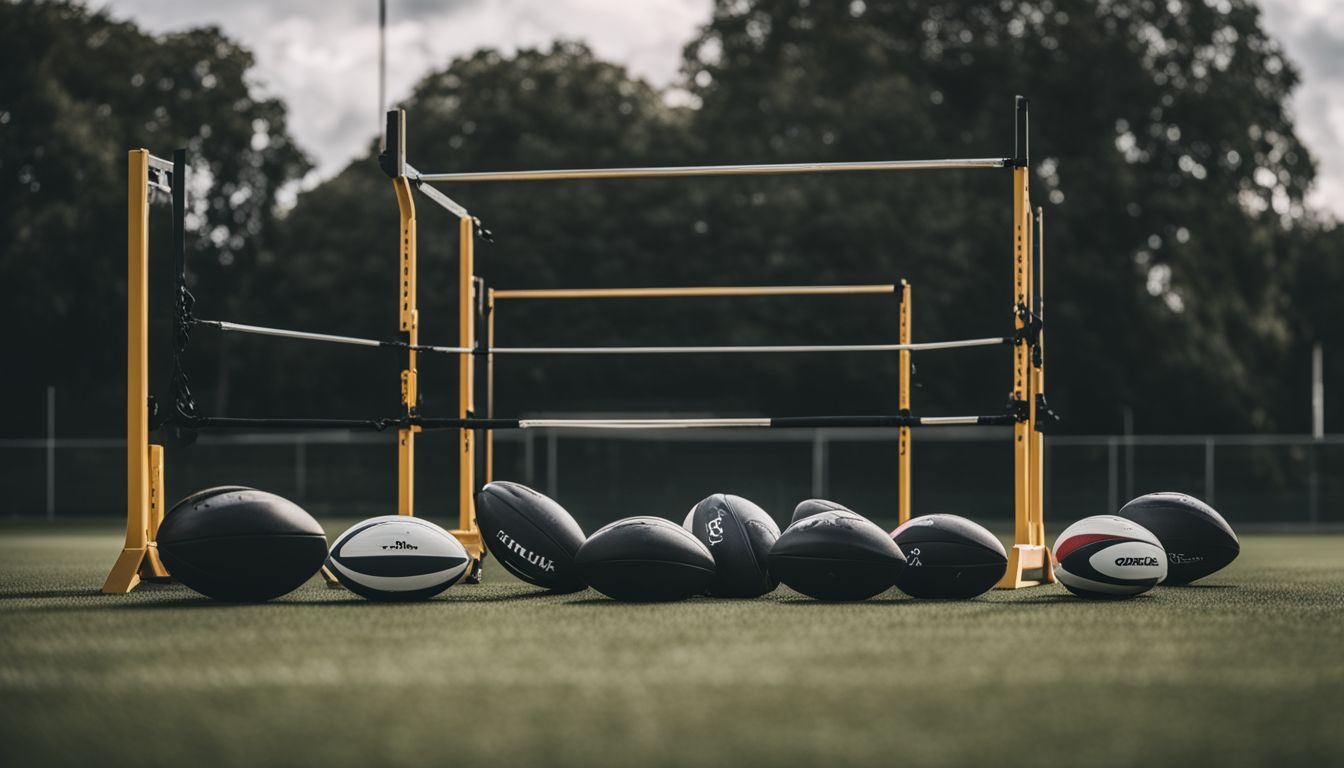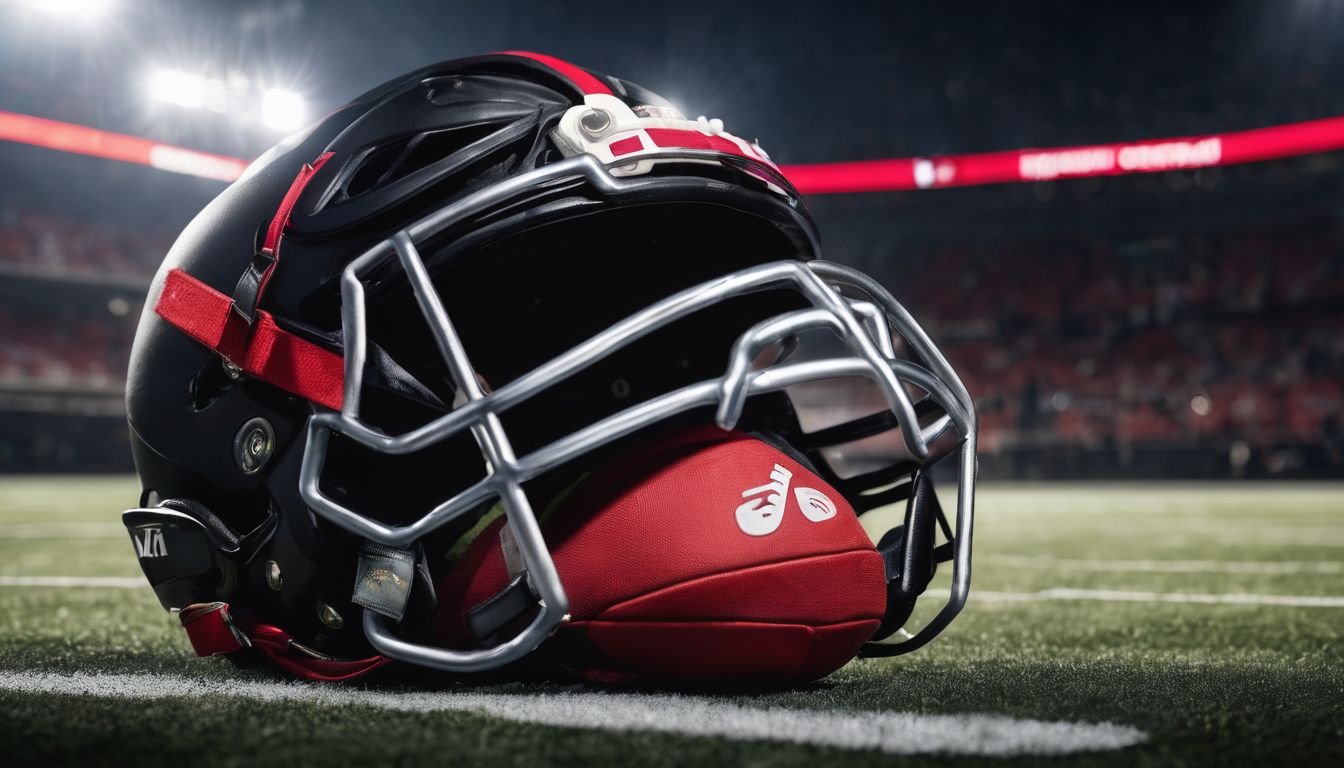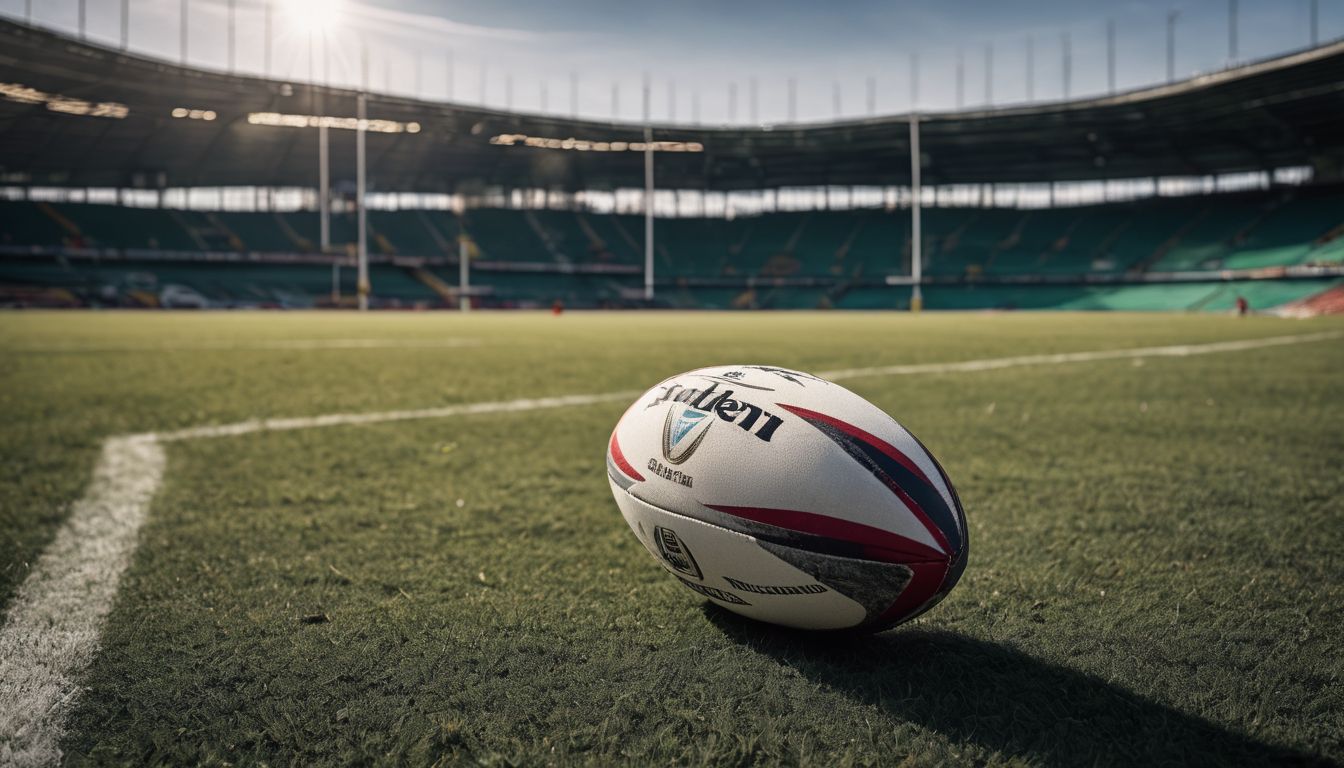Are you keen to boost your rugby game and fitness level? The Six Nations Championship showcases the pinnacle of rugby prowess, honed through rigorous training regimens. In this post, we’ll unveil the powerful training strategies that guide Six Nations Champions towards victory, equipping you with tips to train like a pro.
Dive in for champion secrets!
Key Takeaways
- Six Nations rugby players focus on building strength and endurance through a combination of weightlifting, cardio exercises, and plyometrics to sustain peak performance levels during matches.
- Injury prevention is key in rugby training regimens, involving flexibility exercises, correct tackling techniques, and protective gear to minimise the risk of strains, sprains, and more serious injuries.
- Nutrition and rest are as crucial as physical training. Players follow tailored diets rich in protein for muscle repair and maintain hydration while incorporating adequate rest days for recovery.
- The training routines of Six Nations teams also include personal development aspects such as leadership skills alongside rigorous physical preparation to nurture well-rounded athletes.
- Pre – season training establishes a foundation with emphasis on generalised fitness before transitioning into specialised skill development closer to competitions.
The Importance of Training for Rugby
Training is essential for rugby players as it helps build strength, endurance, and prevents injuries. It also plays a crucial role in improving overall performance on the field.
Building strength and endurance
Strength and endurance form the backbone of any Six Nations champion’s training regime. To succeed on the field, rugby players must combine the power to tackle opponents with the stamina to last through intense matches.
Elite rugby fitness programs therefore focus heavily on exercises that enhance muscle strength and cardiovascular performance. This involves lifting heavy weights for building muscle mass, complemented by running drills and circuit training aimed at boosting lung capacity and heart health.
These athletes dedicate hours each week pushing their limits, often involving a mix of gym sessions, plyometrics, and interval training to simulate the bursts of activity during a game.
Endurance work isn’t just about long runs; it’s about maintaining peak performance levels throughout the entire match – crucial when victory can hinge on decisions made in the final minutes.
With strong muscles and resilient cardio systems, these players embody peak physical conditioning as they prepare their bodies for battle against some of the toughest teams worldwide.
Next up is ensuring all this hard work doesn’t go to waste—let’s delve into how rigorous training aids in preventing injuries.
Preventing injuries
To sustain the strength and endurance built through training, preventing injuries is crucial. Rugby players often face high-impact collisions and intense physical demands, making injury prevention a top priority.
It’s important for players to focus on flexibility and agility exercises to maintain joint mobility and reduce the risk of strains and sprains. Incorporating proper warm-ups and cooldowns into training routines can also help minimise the likelihood of muscle injuries.
Additionally, emphasising proper tackling techniques can lower the risk of head and neck injuries, a critical aspect given the physical nature of rugby. Ensuring that players wear appropriate protective gear during matches is equally essential in preventing serious injuries.
Improving overall performance
To enhance overall performance, rugby players must focus on building both strength and endurance. Lifting heavy weights and engaging in cardio exercises are essential to ensuring that they can handle the physical demands of the sport.
Additionally, rehabilitation and nutrition play crucial roles in aiding recovery and sustaining peak performance levels. The training programmes of Six Nations champions underline the importance of a well-rounded approach to fitness that not only focuses on physical prowess but also emphasises mental resilience and leadership skills for sustained success.
With these comprehensive strategies, rugby players can elevate their game to match the standards set by some of the best teams in the world.
Pre-Season Training Regimen
Prior to the start of the season, rugby teams focus on building a strong foundation through strength and cardio workouts, as well as rehabilitation and nutrition strategies. These regimens are essential in preparing players for the physical demands of the sport.
Building a strong foundation
Rugby players lay the groundwork for success by building a strong foundation through rigorous training routines. This involves focusing on developing strength, endurance, and agility to withstand the physical demands of the sport.
Additionally, emphasis is placed on injury prevention strategies and ensuring overall fitness before moving on to more specialised training.
Starting with a solid base sets the stage for comprehensive development in key areas such as muscular conditioning, cardiovascular endurance, and mental resilience. Players are able to establish a robust platform from which they can progress into more advanced training regimens designed to enhance their performance on the pitch.
Incorporating strength and cardio workouts
Players at the highest levels of rugby integrate both strength and cardio workouts into their training regimens. To excel in the sport, athletes must build muscle power for dynamic movements and endurance for sustained performance during matches.
The ability to swiftly switch between explosive bursts of energy and enduring prolonged physical exertion is essential for success on the pitch. As a result, focusing on incorporating both types of workouts allows players to develop well-rounded fitness that can translate into improved performance during intense rugby matches.
Implementing comprehensive strength and cardio workouts helps rugby players improve not only their physical capabilities but also their mental resilience, enabling them to handle the demands of competitive play effectively.
Rehabilitation and nutrition strategies
Rehabilitation and nutrition strategies are crucial aspects of rugby training, helping players recover from injuries and maintain peak physical condition. Here are key strategies used by Six Nations champions:
- Rehabilitating Injuries:
- Nutrition for Performance:
- Hydration Protocol:
- Mental Recovery Methods:
- Preventive Measures:
- Individualised Plans:
Training Insights from the Six Nations Champions
Gain valuable training insights from the champions of England, Ireland, Scotland, New Zealand, Australia, and Fiji to improve your rugby fitness. Read on to discover their winning strategies and how you can apply them to your own training routine.
England
England Rugby’s training regimen focuses on building both strength and endurance to excel in the Six Nations Championship. Players undergo rigorous workouts that involve lifting heavy weights and enduring cardio exercises to ensure they perform at their peak during matches.
In addition to physical conditioning, emphasis is placed on rehabilitation and nutrition strategies as integral parts of the training program, underscoring the importance of holistic fitness for rugby players.
With a rich history and tradition in rugby, England is renowned for producing some of the finest players in the sport, making their training insights invaluable for aspiring athletes looking to reach the top echelons of rugby.
The England Rugby team also places an important focus on developing leadership skills alongside physical prowess. Understanding that success in rugby extends beyond just athletic ability, players are instilled with crucial personal development lessons through their training programs.
Ireland
Transitioning from the rigorous training insights of England, let’s turn our attention to the dedicated training regimen of Ireland. Rugby fans can learn valuable lessons by examining the fitness routines and leadership development within this successful team.
The Six Nations Championship has witnessed Ireland’s dedication to developing its players’ strength, endurance, and skillset, providing a solid foundation for success on the field.
Ireland’s rugby players are known for their ability to lift significant weights while also possessing exceptional cardio endurance. This focus on physical prowess is complemented by a strong emphasis on rehabilitation and nutrition essentials as integral parts of their comprehensive training program.
Scotland
Transitioning from Ireland to Scotland, it’s essential to note that Scotland’s rugby training routines emphasise the development of strength, agility, and endurance. As a Six Nations contender, their fitness regimen focuses on lifting weights for power and explosiveness while also incorporating cardio workouts to build stamina and speed on the field.
Additionally, rehabilitation and nutrition play crucial roles in ensuring that players are physically prepared for the demands of professional rugby. The Scottish national team is known for its dedication to athletic conditioning and player development, making their training insights valuable for aspiring athletes looking to reach peak performance.
Scotland’s approach encapsulates rigorous physical preparation and strategic leadership skills necessary for success at higher levels of competition within international rugby union.
New Zealand
New Zealand, a dominant force in rugby, emphasises a well-rounded training approach. The All Blacks focus on developing strength and endurance to match the demands of the game. Their rigorous training routines also prioritise injury prevention and overall performance improvement, reflecting their commitment to excellence on and off the field.
New Zealand’s success in the sport highlights the importance of versatile skill development and physical preparation for aspiring players looking to reach the top levels of rugby.
Transitioning now to “Australia”, let’s uncover insights into the training regimens that have led them to success in Six Nations Rugby Championships.
Australia
Australia, a powerhouse in the rugby world, has a rigorous training regimen that focuses on building both strength and endurance. Rugby players in Australia are known for their dedication to lifting heavy weights and enduring long cardio sessions, which are essential for excelling in the sport.
Rehabilitation and nutrition also play a crucial role in the training programs of Australian rugby players, ensuring they stay fit and healthy throughout the season. Additionally, Australia’s focus on developing leadership skills adds an extra dimension to their training regimens, making them well-rounded athletes both on and off the field.
The Six Nations Championship provides valuable insights into what it takes to succeed at the highest level of rugby. The intense competition has produced some of the best rugby players and teams in the world, making it an invaluable resource for fans looking to understand how top-tier athletes train and prepare for success.
Fiji
Fiji, known for its fearless and attacking style of rugby, has made a significant impact in the international rugby scene. The Fijian training regimen focuses on building explosive strength and agility to match their high-paced playing style.
Emphasising fast footwork drills, intense cardio workouts, and powerful weightlifting sessions, Fiji’s training programme aims to create well-rounded athletes capable of dominating on the field.
In addition to physical conditioning, the Fijian team places great importance on rehabilitation strategies and nutrition plans to keep their players in prime condition throughout the season.
Top Tips for Training Like a Six Nations Champion
– Training with purpose, prioritising functional muscle over aesthetics, making training enjoyable, managing nutrition and rest days, setting and reviewing goals.
Training with purpose
Training with purpose is essential for rugby players aiming to excel in their sport. To achieve success, it’s crucial to have clear goals and a focused approach to training. Conditioning plans for Six Nations champions emphasise the importance of setting and reviewing goals regularly.
By doing so, individuals can ensure that their efforts are directed towards continuous improvement, helping them reach peak performance on the field.
Rugby players from the top teams understand that each workout serves a specific purpose in enhancing their skills and fitness levels. They prioritise functional muscle development over aesthetics, aligning every exercise with improving their performance on the pitch.
Prioritising functional muscle over aesthetics
Transitioning from training with purpose, prioritising functional muscle over aesthetics is essential for rugby players striving to reach the top of their game. Unlike bodybuilding, where the focus is on appearance, rugby players need strength and power that directly translate to performance on the field.
Functional muscle supports agility, speed, and explosive movements crucial in a fast-paced game like rugby. Building this type of muscle involves targeted resistance training and dynamic exercises that simulate game situations.
Rugby players must prioritise real-world strength gains over superficial looks as they aim to excel in a sport that demands raw power and athleticism. The emphasis lies upon cultivating physical capacities that directly benefit performance rather than purely aesthetic attributes.
Making training enjoyable
To make training enjoyable, rugby players can incorporate diverse activities and drills into their routines. Mixing up workouts with variations of strength and cardio exercises can keep the sessions stimulating and challenging.
Engaging in team building activities or friendly competitions during training sessions can add an element of fun while also fostering camaraderie among players.
Creating a supportive and positive environment during training can also significantly contribute to making it more enjoyable for everyone involved. Encouraging open communication, providing constructive feedback, and celebrating small victories can help boost morale and motivation within the team.
Managing nutrition and rest days
Rugby players need to pay attention to their nutrition on rest days as it plays a crucial role in recovery and overall performance. Ensuring adequate intake of protein, carbohydrates, and healthy fats is essential for muscle repair and energy replenishment.
Hydration is also key – maintaining optimal fluid levels aids in preventing fatigue and injuries during training sessions.
Rest days are equally important for allowing the body to recover from intense workouts. Adequate sleep is crucial for muscle repair and growth, helping players stay fresh and focused during training periods.
Setting and reviewing goals
Rugby players at all levels can benefit from setting specific and achievable goals. By identifying areas for improvement, such as increasing speed or endurance, players can tailor their training to meet these aspirations.
Regularly reviewing and adjusting these objectives ensures that progress is being made and motivates players to push themselves further. Tracking performance against set targets also provides a clear indication of development over time, allowing players to continually strive for excellence in their game.
Striving for improvement on the rugby pitch requires dedication, hard work, and the drive to constantly progress. Setting individual goals helps athletes focus their efforts effectively while remaining committed to personal advancement in the sport.
Conclusion
In conclusion, the training regimens of Six Nations champions offer valuable insights for rugby enthusiasts to improve their skills and fitness levels. Lessons learned from these top teams can help individuals transform their approach to training and enhance their performance on the field.
By adopting the strategies used by elite players, aspiring rugby athletes can elevate their game and strive towards success in the sport they love.
FAQs
1. What kind of training do Six Nations rugby champions go through?
Six Nations champions follow rigorous training regimens that include rugby fitness routines, cardio endurance exercises, and leadership development to ensure long-term player development.
2. How often do Six Nations rugby players train?
Rugby player training for the Six Nations usually involves daily fitness sessions, skill drills, and strategic plays as part of a preseason program aimed at peak physical preparation.
3. Do women’s rugby teams have different training programs?
Yes, women’s rugby training programs are tailored specifically for female athletes but still incorporate intense fitness plans and exercise routines similar to those used by male Six Nations winners.
4. Are there special workouts for Rugby captains?
Rugby captains often engage in additional leadership skills training on top of their regular athletic regimens, ensuring they can lead effectively both on and off the field.
5. Can young players follow the same fitness regimen as Six Nations champions?
Youth rugby training regimens adapt principles from champion workout schedules while focusing on safe long-term player development appropriate for growing bodies.









